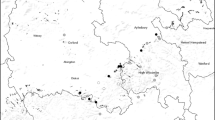Abstract
Lepidoptera have attracted more attention than other insects in the development of insect conservation, commonly as charismatic ‘flagship‘ species. Wider benefits of conservation studies on single species include developing and clarifying their role as putative ‘umbrella‘ taxa whereby their protection also confers protection on coexisting organisms which are not as well documented. Examples are given of such umbrella Lepidoptera from the Australian region, and the values of documenting and defining changes in lepidopteran assemblages (for example, through analysis of light-trap catches of moths) as correlates of environmental change are outlined. Selection of optimal groups depends on documenting responses of both species and higher taxa to changes in vegetation or microclimate in particular. Potent umbrella taxa manifest many of the features of indicator and flagship taxa.
Similar content being viewed by others
References
Barlow, H.S. and Woiwod, I.P. (1989) Moth diversity of a tropical forest in Peninsular Malaysia. J. Trop. Ecol. 5, 37–50.
Beccaloni, G.W. and Gaston, K.J. (1995) Predicting the species richness of Neotropical forest butterflies: Ithomiinae (Lepidoptera: Nymphalidae) as indicators. Biol. Conserv. 71, 77–86.
Britton, D.R., New, T.R. and Jelinek, A. (1995) Rare Lepidoptera at Mount Piper, Victoria–the role of a threatened butterfly community in advancing understanding of insect conservation. J. Lepidopt. Soc. 49, 97–113.
Brown Jr, K.S. (1991) Conservation of Neotropical environments: insects as indicators. In The conservation of insects and their habitats(N.M. Collins and J.A. Thomas, eds) pp. 350–404. London: Academic Press.
Common, I.F.B. (1994) Oecophorine genera of Australia I. The Wingia group (Lepidoptera: Oecophoridae). CSIRO: Melbourne.
Erhardt, A. (1985) Diurnal Lepidoptera: sensitive indicators of cultivated and abandoned grassland. J. Appl. Ecol. 22, 849–61.
Erhardt, A. and Thomas, J.A. (1991) Lepidoptera as indicators of change in the semi-natural grasslands of lowland and upland Europe. In The conservation of insects and their habitats(N.M. Collins & J.A. Thomas, eds) pp. 213–36. London: Academic Press.
Hebert, P.D.N. (1980) Moth communities in montane Papua New Guinea. J. Anim. Ecol. 49, 593–602.
Hebert, P.D.N. and Harmsen, R. (1984) Species diversity patterns in moth communities of Papua New Guinea. In Tropical Rain-Forest. The Leeds Symposium(A.C. Chadwick and S.L. Sutton, eds) pp. 306–7. Special Publication of the Leeds Philosophical and Literary Society.
Holl, K.D. (1996) The effect of coal surface mine reclamation on diurnal lepidopteran conservation. J. Appl. Ecol. 33, 225–36.
Holloway, J.D. (1977) The Lepidoptera of Norfolk Island, their biogeography and ecology. The Hague: W. Junk.
Holloway, J.D. (1979) A survey of the Lepidoptera, biogeography and ecology of New Caledonia. The Hague: W. Junk.
Holloway, J.D. (1984) Moths as indicator organisms for categorising rain-forest and monitoring changes and regeneration processes. In Tropical Rain-Forest. The Leeds Symposium(A.C. Chadwick and S.L. Sutton, eds) pp. 235–42. Special Publication of the Leeds Philosophical and Literary Society.
Holloway, J.D. (1994) The relative vulnerabilities of moth higher taxa to habitat change in Borneo. In Systematics and Conservation Evaluation(P.I. Forey, C.J. Humphries and R.I. Vane-Wright, eds) pp. 197–205. Oxford: Clarendon Press.
Holloway, J.D. and Stork, N.E. (1991) The dimensions of biodiversity: the use of invertebrates as indicators of man’s impact. In The biodiversity of microorganisms and invertebrates: its role in sustainable agriculture(D.L. Hawksworth, ed.) pp. 137–62. Wallingford: CAB International.
Kremen, C. (1992) Assessing the indicator properties of species assemblages for natural areas monitoring. Ecol. Appl. 2, 203–17.
Kremen, C. (1994) Biological inventory using target taxa: a case study of the butterflies of Madagascar. Ecol. Appl. 4, 407–22.
Kudrna, O. (1986) Butterflies of Europe. 8. Aspects of the Conservation of Butterflies in Europe. Weisbaden: Aula-Verlag.
Launer, A.E. and Murphy, D.D. (1994) Umbrella species and the conservation of habitat fragments: a case of a threatened butterfly and a vanishing grassland ecosystem. Biol. Conserv. 69, 145–53.
Mattoni, R.H.T. (1993) The Palos Verdes Blue, Glaucopsyche lygdamus palosverdesensisPerkins and Emmel. In Conservation Biology of Lycaenidae(T.R. New, ed.) pp. 135–6. Gland: IUCN.
McQuillan, P.B. (1986) Trans-Tasman relationships in the highland moth (Lepidoptera) fauna. In Flora and Fauna of alpine Australasia ages and origins(B.A. Barlow, ed.) pp. 265–76. Australia: CSIRO/Leiden: E.J. Brill.
Murphy, D.D. and Wilcox, B.A. (1986) Butterfly diversity in natural habitat fragments: a test of the validity of vertebrate-based management. In Wildlife 2000, Modelling habitat relationships of terrestrial vertebrates(J. Verner, M. Morrison and C.J. Ralph, eds) pp. 287–92. Madison: University of Wisconsin Press.
Nelson, S.M. and Andersen, D.C. (1994) An assessment of riparian environmental quality by using butterflies and disturbance susceptibility scores. Southw. Nat. 39, 137–42.
New, T.R., Britton, D.R., Hinkley, S.D. and Miller, L.J. (1996) The ant fauna of Mount Piper and its relevance to environmental assessment and the conservation of a threatened invertebrate community. Flora & Fauna Technical ReportNo.143, Department of Natural Resources and Environment, Victoria.
Neyland, M. (1993) The ecology and conservation management of the ptunarra brown butterfly Oreixenica ptunarra (Lepidoptera; Nymphalidae; Satyrinae) in Tasmania, Australia. Pap. Proc. R. Soc. Tasm. 127, 43–8.
Packer, L. (1991) The status of two butterflies, Karner Blue (Lycaeides melissa samuelis) and Frosted Elfin (Incisalia irus), restricted to oak savannah in Ontario. In Conserving Carolinian Canada(G.W. Allen, P.F.J. Eagles and S.W. Price, eds) pp. 327–31. Ontario: University of Waterloo Press.
Parsons, M.J. (1984) The biology and conservation of Ornithoptera alexandrae. In The Biology of Butterflies (P.R. Ackery and R.I. Vane-Wright, eds) pp. 327–31. London: Academic Press.
Parsons, M.J. (1992) The world’s largest butterfly endangered: the ecology, status and conservation of Ornithoptera alexandrae(Lepidoptera: Papilionidae). Trop. Lepidoptera 3, Supplement 1, 33–60.
Robinson, G.S. and Tuck, K.R. (1993) Diversity and faunistics of small moths (Microlepidoptera) in Bornean rainforest. Ecol. Entomol. 18, 385–93.
Samways, M.J. (1994) Insect Conservation Biology. London: Chapman & Hall.
Scoble, M.J. (1992) The Lepidoptera. Oxford: Oxford University Press.
Usher, M.B. (1986) Wildlife Conservation Evaluation. London: Chapman & Hall.
Young, A.M. (1982) Population Biology of Tropical Insects. New York & London: Plenum.
Rights and permissions
About this article
Cite this article
New , T. Are Lepidoptera an effective ‘umbrella group‘ for biodiversity conservation?. Journal of Insect Conservation 1, 5–12 (1997). https://doi.org/10.1023/A:1018433406701
Issue Date:
DOI: https://doi.org/10.1023/A:1018433406701




